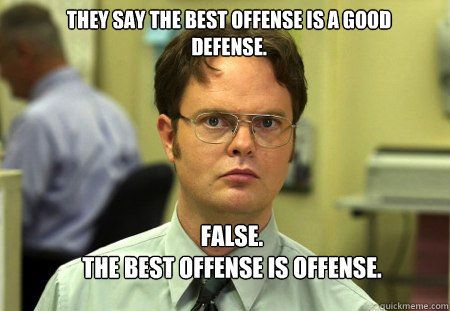

Hey, it finally feels like spring! As the weather warms up and days get longer, many of you will be hitting the road for runs more often and for longer periods of time. Whether you’re a new runner doing a “Couch to 5K” (welcome!) or an experienced road warrior training for your 15th marathon (slow down, you’re making us look bad!), it’s important to stay attuned to your body to prevent injury and maintain your level of activity throughout the spring, summer and beyond. Physical therapy can be instrumental in helping you avoid injuries, or supporting your return from injury to a full level of activity.
They say the best offense is a good defense, and while that has literally nothing to do with running, the general philosophy can be applied to your training; after all, you don’t have to rehab 100% of the injuries you never sustain.


We think Dwight is missing the point.
Physical therapists at PTSMC help you prevent injury by guiding you in:
• Proper running form
• New training methods and techniques
• Proper shoe selection
• Proper pre-and-post running stretches and exercises.
Unfortunately, injuries do happen. Common problems for runners can include Plantar Fasciitis, Tendinitis and IT Band Syndrome, along with general muscle strains, knee pain, foot pain – the list goes on. If you sustain an injury, or if you’re returning from a recent injury, PTSMC is here to help. Getting back into the swing of things can often feel like a frustrating combination of good days and bad days, but your physical therapist can help make sure you progress towards a full return to activity by offering:
• Comprehensive and knowledgeable injury diagnosis
• Custom PT plan fit for your needs
• Manual physical therapy
• Gym and home rehab exercise program
• Education on proper form and equipment to prevent future injury and re-aggravation
Lacing up on a warm and sunny day after a long, cold winter can be one of the great joys for runners in New England, but the enthusiasm can often lead to pain and injury. Physical therapists at PTSMC can offer both injury prevention and rehab for runners. Our goal is to help you get the most out of your training, avoid the pitfalls that can sideline novices and experienced runners alike, and get you back on the road if you do sustain an injury. Remember – most people do not need a doctor’s referral to see a physical therapist. If you’d like to learn injury prevention techniques, or if you’re dealing with pain, you can schedule an appointment at any one of our PTSMC locations around Connecticut. Happy running!
LEARN MORE ABOUT PTSMC TREATMENT FOR RUNNERS’ INJURIES HERE.
